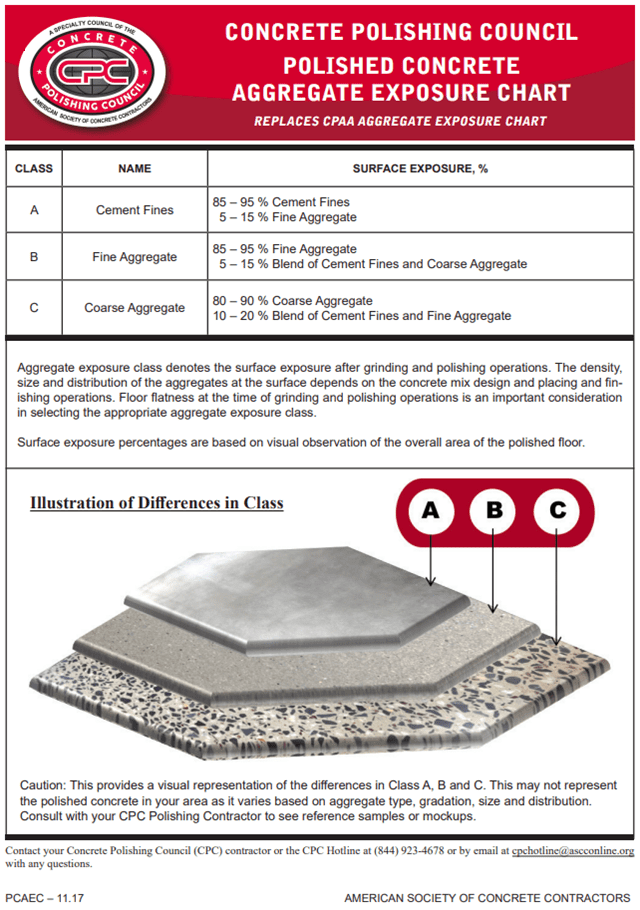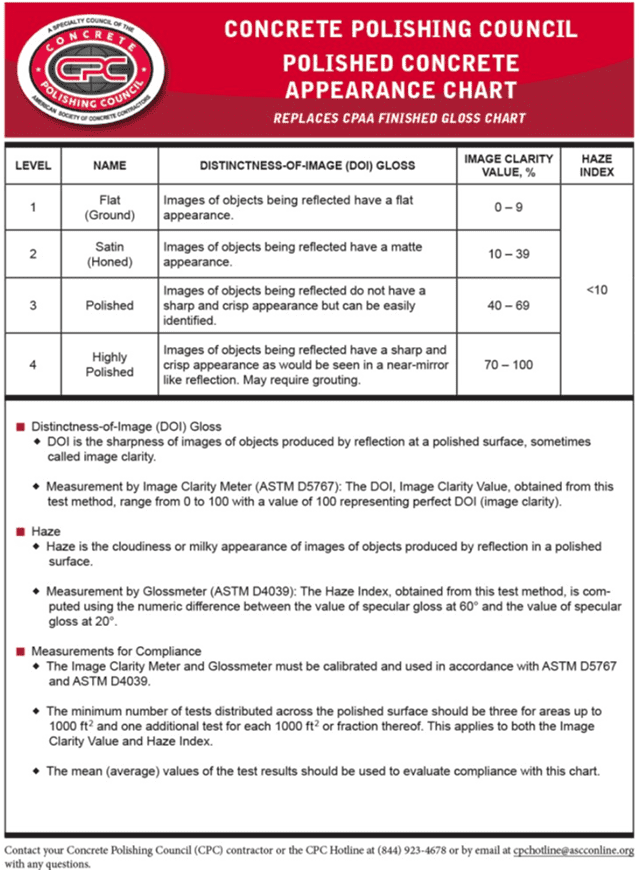When home and business owners decide to invest in concrete flooring, there are numerous benefits that they’ll enjoy, from durability to stain resistance.
As you’re maintaining the floors, you must be aware of what to do in case you start to notice some damage.
Does polished concrete scratch? If so, how do you fix it? How do you keep the polished concrete looking like new? Keep reading to learn more.
Do Polished Concrete Floors Scratch Easily?
Amongst the most resilient types of flooring available, polished concrete floors do not get scratched easily. This factor is why many industries utilize a concrete substrate or concrete for commercial flooring in high-traffic areas such as retail stores, hospitals, malls, schools, and more. The concrete polishing process – including the surface preparation process, concrete grinding, adding a densifier and sealing – makes polished and sealed concrete floors highly resistant to scratching.
Is There a Sealer for Concrete?
There are two primary types of sealers for concrete: penetrating and film-forming.
A film-forming concrete sealer is a floor coating on the concrete surface, like urethanes and acrylics. An epoxy floor is a popular choice for a topical sealer, as it lasts long.
On the other hand, acrylics are more likely to succumb to dirt, stains, and typical wear and tear. Therefore, you’d have to apply this sealant more often. You should select the film-forming sealant for that high-gloss finish, making your color appear more vibrant.
A penetrating sealer includes silicates, siloxanes, silicones, and silanes that build a chemical barrier by penetrating through the surface of the concrete slab.
These penetrating sealants carry a longer lifespan and work best with exterior applications because they won’t delaminate or peel. You can also use this sealer indoors, but it will give a more natural and rustic-looking concrete finish.
Is Polished Concrete High Maintenance?
Polished concrete is not a high-maintenance flooring option. Concrete polishing makes the floor vitally indestructible, though there are still some things that you should do to keep it looking its best.
For example, you should wipe or mop spills to prevent them from staining the concrete.
Additionally, don’t use abrasive chemicals or cloths on the floor to preserve the surface’s smoothness and shine.
Also, for areas with a lot of traffic, you should be polishing with an approved polish once a week. Will polished concrete scratch? It can, but it’s not very likely if the installation is top-notch.
Does Polished Concrete Need To Be Sealed?
A polished floor isn’t the same thing as having a sealed floor. Polishing concrete means a contractor uses an abrasive coated with very small diamond pieces to grind the floors.
A sealed concrete floor indicates that you used a sealant to cover the floor or penetrate it to create a barrier to protect it. You may also add sealant to the polish for additional floor protection.
So, while you don’t necessarily need a sealer on a polished concrete surface for it to fare well, it would be beneficial to add one to the polish. The best choice is a polished floor because it looks better aesthetically, but adding the sealer gives more value.
How Do You Fix Scratches on a Polished Concrete Floor?
One of the greatest benefits of having polished concrete flooring is that it’s very resilient and robust. It’s able to stand up to wear and tear caused by heavy equipment and heavy foot traffic. It’s virtually impossible to scratch and very hard to damage.
But, if you see a scratch on the floor, the only way to remove it is by regrinding it.
The best material that you can go at this with is a diamond pad for your polished concrete floor. You must choose the right kind of pad, as you want to avoid damaging your floor while trying to do a concrete repair.
You want to begin with a finer grit that isn’t very aggressive and go up from there. These charts courtesy of the American Society of Concrete Contractors should be used as as a guide:


How Do You Remove Scuff Marks From Polished Concrete?
Although concrete surfaces are durable and robust, they’re not incapable of getting scuffed. Like other surfaces, concrete can get scuffed, mainly where people and pets are constantly walking.
If you are someone who had a concrete installation, the contractor should have left with detailed instructions on how to care for your concrete surfaces specifically.
However, if you decide to try your hand at removing scuffs on concrete surfaces without formal instructions, begin with the easiest cleaning method and then try your hand at more intense cleaning methods.
Try wetting a soft-bristled brush. Use one without metal bristles to avoid further scratching the concrete, and scrub the scuffed area firmly. Surprisingly a lot of times, a little elbow grease and some water are sufficient to remove scuffs from a concrete floor.
A concrete scrubber is also very effective at removing scuff marks from concrete surfaces.
Additionally, you can try baking soda or spray lubricant onto the floor to remove the scuff from the floor. If the scuff is stubborn and remains after you’ve tried these methods, call a contractor or get help from a professional.
Chances are you have a stain in your concrete instead of a scuff on top of it. In this case, you’ll have to penetrate the surface of the concrete to clean the stain and then re-seal the concrete.
How Do You Protect Concrete From Scratches?
Remember that concrete flooring is simple to maintain and keep clean. Vacuuming or sweeping the floor consistently and mopping it each week will get the job done. Always use a cleaner with a neutral pH balance to avoid corrosive effects.
Does polished concrete scratch? Even though the surface is resistant to scratches, accidents still happen. It just means they’re harder to come by.
You still have to take the proper measures to shield your floors from scratches. Here are some tips on the most effective ways to keep etchings and scratches off your concrete floors.
Prevent debris and dirt from entering the home or business by using a doormat for each entrance. You can easily safeguard your polished floor from various types of damage by minimizing how much dirt gets brought in.
Use a rug for areas that get a lot of foot traffic. This may be somewhere like a front door, desk, cash register, coffee table, and so on. Not only is it a stylish option to limit etchings, scratches, and scuffs, but it serves as a way to preserve the surface.
Refrain from dragging heavy appliances or furniture across the room. Find better methods to move your furniture around the home rather than pulling them around and scraping the floor. Even if you’re going slowly, it’s still damaging. Try lifting the item entirely and then transporting it somewhere else.
For homeowners with polished concrete floors, be sure to train your pets properly. One of the easiest ways to incur wear and tear on your floors is to allow your cats and dogs to claw away at the floor. If left unchecked, your floors will sustain considerable damage in a short timeframe, ultimately decreasing their lifespan.
If you follow these tips, you’ll certainly stand a good chance of your concrete floors looking good well into the future.